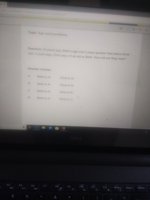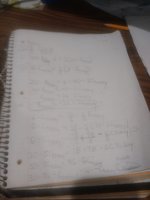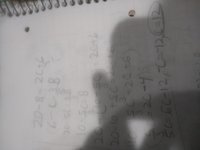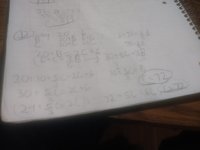You are using an out of date browser. It may not display this or other websites correctly.
You should upgrade or use an alternative browser.
You should upgrade or use an alternative browser.
I don't get this problem
- Thread starter ironsheep
- Start date
pka
Elite Member
- Joined
- Jan 29, 2005
- Messages
- 11,978
ironsheep, None of your post is readable. Please type out your questions and answers.Here are my attempts:
Dr.Peterson
Elite Member
- Joined
- Nov 12, 2017
- Messages
- 16,875
I can almost read some of that, but not enough to want to try.
Please give us readable images, and type out at least the problem itself. Also, it will help tremendously if you can tell us in words what you are thinking, and ask some specific questions. If you haven't already, please read the submission guidelines.
I did some processing on your images to make them a little easier to read, and I can at least make a comment or two.
Here are improved versions of the problem and your first page of work:
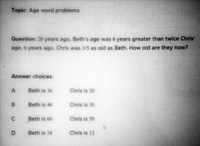
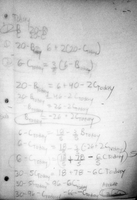
First comment: Beth's age 20 years ago is not 20 - B; it's B - 20.
Second comment: to see what the equations (and expressions) will look like, you might want to start by "checking" one of the options. If Beth is 36 and Chris is 20, then 20 years ago, Beth was 36 - 20 = 16, and Chris was 20 - 20 = 0. The first claim is that 16 is 6 more than twice 0. It isn't, so this is wrong. But what would this look like in terms of variables B and C?
Please give us readable images, and type out at least the problem itself. Also, it will help tremendously if you can tell us in words what you are thinking, and ask some specific questions. If you haven't already, please read the submission guidelines.
I did some processing on your images to make them a little easier to read, and I can at least make a comment or two.
Here are improved versions of the problem and your first page of work:


First comment: Beth's age 20 years ago is not 20 - B; it's B - 20.
Second comment: to see what the equations (and expressions) will look like, you might want to start by "checking" one of the options. If Beth is 36 and Chris is 20, then 20 years ago, Beth was 36 - 20 = 16, and Chris was 20 - 20 = 0. The first claim is that 16 is 6 more than twice 0. It isn't, so this is wrong. But what would this look like in terms of variables B and C?
Last edited:
I figured out that problem, but now I am stuck on a new problem. "Jordan is 16 years older than Ryan. In 6 years, Jordan will be twice as old as Ryan. How old is Jordan now?
I have been following the advice of this guy:
. I didn't like the idea of using only one variable because it got confusing and I used two different variables to tackle the first problem I had trouble with.
Now: Jordan + 16
Ryan
six years: J + 22
R + 6
j + 22 = 2R
J = R+16
J + 22= 2(R+6)
J + 22= 2R + 12
R+ 16+ 22= 2R + 12
R+ 38= 2R +12
38= R+12
R=26
Answer choices are : 26, 24, 18, and 10.
Jordan is older than Ryan
I have been following the advice of this guy:
Now: Jordan + 16
Ryan
six years: J + 22
R + 6
j + 22 = 2R
J = R+16
J + 22= 2(R+6)
J + 22= 2R + 12
R+ 16+ 22= 2R + 12
R+ 38= 2R +12
38= R+12
R=26
Answer choices are : 26, 24, 18, and 10.
Jordan is older than Ryan
Well, if you're ever uncertain if an answer is correct or not you can always check it yourself. Immediately we can see we have a big problem because your answer says that Ryan is 26 years old. But the question asks about Jordan's age. If Ryan is 26 years old then "Jordan is 16 years older than Ryan" means that Jordan would be 26 + 16 = 42. This is not one of the answer choices.  As another means of checking, we can follow it through to its logical conclusion. If Jordan is 42 years old now, he will be 42 + 6 = 48 in six years. Similarly Ryan will be 26 + 6 = 32 in six years. We can plainly see that 48 is not twice 32, so no go on that.
As another means of checking, we can follow it through to its logical conclusion. If Jordan is 42 years old now, he will be 42 + 6 = 48 in six years. Similarly Ryan will be 26 + 6 = 32 in six years. We can plainly see that 48 is not twice 32, so no go on that.
Given this, it's only logical to try and figure out where you might have gone wrong. Beginning from the assertion that \(\displaystyle J + 22= 2(R+6)\), all of your math works out correctly, so we know there must be an error in the setup leading to this equation. Using multiple variables in this problem seems unorthodox to me but it can be done - you just have to be very careful when you establish what each variable represents and carefully think about the repercussions of those choices.
You don't explicitly state what the variables represents in your workings, but you say that \(\displaystyle J = R+16\), which leads me to believe that \(J\) represents Jordan's age now. Logically this means that the left-hand side of the equation, \(J + 22\) represents Jordan's age 22 years from now. In the same manner, I can only assume that \(R\) represents Ryan's age now. The right-hand side of the equation, \(2(R + 6)\) then represents twice {Ryan's age's six years from now}. So now you have to ask yourself: Given what the problem asks for, does the left-hand side of the equation make sense? Why or why not? If not, what might you do to fix it? And does the right-hand side of the equation make sense? Why or why not? If not, what might you do to fix it?
Given this, it's only logical to try and figure out where you might have gone wrong. Beginning from the assertion that \(\displaystyle J + 22= 2(R+6)\), all of your math works out correctly, so we know there must be an error in the setup leading to this equation. Using multiple variables in this problem seems unorthodox to me but it can be done - you just have to be very careful when you establish what each variable represents and carefully think about the repercussions of those choices.
You don't explicitly state what the variables represents in your workings, but you say that \(\displaystyle J = R+16\), which leads me to believe that \(J\) represents Jordan's age now. Logically this means that the left-hand side of the equation, \(J + 22\) represents Jordan's age 22 years from now. In the same manner, I can only assume that \(R\) represents Ryan's age now. The right-hand side of the equation, \(2(R + 6)\) then represents twice {Ryan's age's six years from now}. So now you have to ask yourself: Given what the problem asks for, does the left-hand side of the equation make sense? Why or why not? If not, what might you do to fix it? And does the right-hand side of the equation make sense? Why or why not? If not, what might you do to fix it?
Dr.Peterson
Elite Member
- Joined
- Nov 12, 2017
- Messages
- 16,875
It looks like you tried to make a table, but I can't follow it. I would use this table, if you want to use two variables (which is not a bad idea):"Jordan is 16 years older than Ryan. In 6 years, Jordan will be twice as old as Ryan. How old is Jordan now?
I didn't like the idea of using only one variable because it got confusing and I used two different variables to tackle the first problem I had trouble with.
Now: Jordan + 16
Ryan
six years: J + 22
R + 6
j + 22 = 2R
J = R+16
J + 22= 2(R+6)
J + 22= 2R + 12
R+ 16+ 22= 2R + 12
R+ 38= 2R +12
38= R+12
R=26
Answer choices are : 26, 24, 18, and 10.
Jordan is older than Ryan
| Now | 6 years from now | |
|---|---|---|
| Jordan | J | J + 6 |
| Ryan | R | R + 6 |
You seem to be mixing up the one-variable approach with your own. The advantage of using two variables is that you can directly translate statements into equations without trying to solve anything at the start. So Jordan's age now is just J, not J + 16, as you appear to be saying. Your first equation, J + 22 = 2R, is wrong, but your second, J = R + 16, is correct.
Give it another try. I think you'll get it if you start with my table.
Now, if you used one variable, it would probably be R, and in place of J you would use R + 16.
The problem with checking answers against what your teacher wrote as possible answer choices is that the teacher might have messed up in creating the problem and she might've messed up in solving her own problem.
I got it, I used Dr.Peterson's table and I added the formula J= R+16 into the whole process as this formula is very nice since it gives an isolated variable already, J. J equals R +16.
ksdhart2
said that J+22=2(R+6) is correct, which is supported by the table left by Dr.Peterson, so all I have to do is substitute J = R +16 into the equation J+22= 2(R+6). I got the answer 10 for Ryan and then 10 + 16 equals 26 as Jordan is always 16 years older than Ryan.
The glue that really holds everything together is when dealing with variables is to write the subscript today or present to each variable. The variable never changes as the present age of the person doesn't change. Without the subscript to the variable, I might get confused.
I thank everyone for contributing in a postive, helpful way in aiding me to solve "age old problems."
I got it, I used Dr.Peterson's table and I added the formula J= R+16 into the whole process as this formula is very nice since it gives an isolated variable already, J. J equals R +16.
ksdhart2
said that J+22=2(R+6) is correct, which is supported by the table left by Dr.Peterson, so all I have to do is substitute J = R +16 into the equation J+22= 2(R+6). I got the answer 10 for Ryan and then 10 + 16 equals 26 as Jordan is always 16 years older than Ryan.
The glue that really holds everything together is when dealing with variables is to write the subscript today or present to each variable. The variable never changes as the present age of the person doesn't change. Without the subscript to the variable, I might get confused.
I thank everyone for contributing in a postive, helpful way in aiding me to solve "age old problems."
...ksdhart2 said that J+22=2(R+6) is correct...
No, actually, I did not say this. In fact, I said the exact opposite! What I was trying to indicate was that, if you start from the faulty premise, the workings are good. This, then, indicates that your error is not in the actual math itself, but in some confusion as to what the variables represent.
Otis
Elite Member
- Joined
- Apr 22, 2015
- Messages
- 4,589
Good grief! With such an attitude, I can't see how you take anything at face value.The problem with checking answers against what your teacher wrote ... is that the teacher might have messed up in creating the problem and she might've messed up in solving her own problem ...
? Begin by assuming materials are correct, and check your own results.
When there's an issue that you cannot identify, then consider the possibility that you need to verify a given answer or step.
\(\;\)

